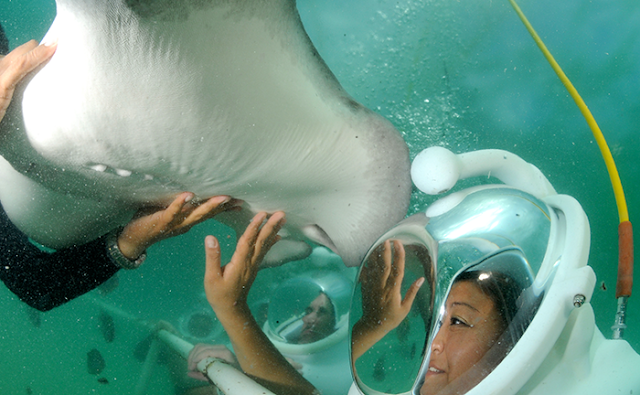Who glides through the ocean with the greatest of ease? The spectacular stingray, that’s who! These comely creatures are popular to aquarium visitors and divers alike, due to their elegant appearance and friendly dispositions.
Stingrays aren’t just ocean dwellers, they can be found in lakes and rivers alike. They feed on crustaceans, small fish, snails, clams and other small creatures. They use a super set of senses to search for food. Special gel-filled pits across the front of their face, (called Ampullae of Lorenzini), allow them to pick up electrical signals from other animals when they move. Their eyes are on the topside of their body and their mouth and gills can be found underneath, so in the darker depths or murky rivers, this electromagnetic sense is especially useful for searching for prey. They uncover prey by blowing water out through their mouths and flapping their "wings" over the sand. Like sharks, rays have a conveyor belt of teeth that will constantly be replaced throughout their lifetime.
Baby stingrays are born fully developed and look like miniature versions of adult animals. They are fully proportioned, and are naturally good swimmers from birth. This helps them find food on their own right away, though mothers still stick around to provide protection until around age three or so. Did we mention they also look like cute raviolis?
Stingrays are known for the barbs on their tails, but they are actually very docile and social creatures. They can be found individually, in pairs, or in loose groups (called a “fever”). If threatened, they can raise their tails like a scorpion and stab predators with their venomous barb. However, they are more likely to swim away from predators. Normally, they act kind and gentle around humans. Our Sea TREK operator at Xcaret in Cancun, Mexico can attest to the friendliness of rays. Local resident, Stubby the Stingray, loves socializing with TREKKERs! Named Stubby due to her short tail (perhaps lost in a battle with an envious shark), Stubby swims around divers and guests on a daily basis, just for the fun of it!
Sadly, numbers of stingrays are in decline. Overfishing, habitat loss and climate change are the major threats to rays. They are also hunted for their gill rakers (used for feeding), for use in Chinese medicine. Currently, 107 species stingrays are classified as threatened. Fortunately, a number of organizations are working to protect stingrays from their threatened status. The Leonardo DiCaprio foundation supports the protection of stingrays and sharks through a collaborative partnership with several other conservation groups. Read about their efforts here. Additional strategies to protect rays are being developed via the Global Priorities for Conserving Sharks and Rays program. Read about the program here.
If you’d like to meet a stingray and experience firsthand their docile and friendly demeanor, sign up for the Sea TREK with stingrays program at one of our facilities:
http://www.xcaret.com/sea-trek-stingrays-cancun.php
http://www.xelha.com/sea-trek-stingray-xelha-park.php





No comments:
Post a Comment
Thank you for your comment!